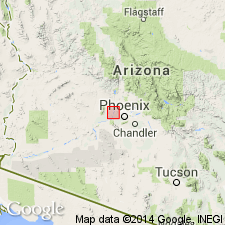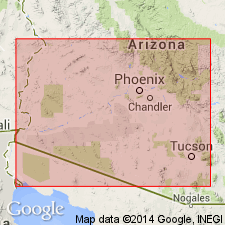
- Usage in publication:
-
- Luke salt body*
- Modifications:
-
- First used
- Dominant lithology:
-
- Salt
- AAPG geologic province:
-
- Basin-and-Range province
Summary:
First published use as an informal unit name applied to a salt (halite) body of nonmarine origin in vicinity of Luke Air Force Base which is in Maricopa Co, AZ. Occurrence of salt shown on index map as in Pinal, Maricopa, Yavapai, and Yuma Cos, AZ in the Basin-and-Range province. Has been penetrated in many wells. The salt body is an irregular ridge-like mass that has an arcuate crest with several local domes and a broad triangular base. The salt body may be a structural massif formed by plastic flow or, as proposed by authors, it may be a thick steep-sided prism of evaporites in the center of a clastic sedimentary basin. The base of the salt may be at 6,900 ft; only the upper 3,000 ft have been penetrated. The salt body is overlain locally by anhydrite 90 ft thick. Is thought to be intertongued with coarse- to fine-grained valley fill of Tertiary age. Is probably pre-Pliocene in age and older than the Pliocene Verde Formation.
Source: GNU records (USGS DDS-6; Denver GNULEX).

- Usage in publication:
-
- Luke Salt Member
- Modifications:
-
- Revised
- AAPG geologic province:
-
- Basin-and-Range province
Summary:
Revised as the Luke Salt Member of the Miocene Hickey Formation. Name credited to Eaton and others (1972). Described as a massive salt of nonmarine origin. More than 1,219 m penetrated in one well without reaching base of salt. Cross sections; correlation chart. Shown as in upper part of Hickey intertongued with an alluvial sequence. Underlying and overlying parts of Hickey are unnamed.
Source: GNU records (USGS DDS-6; Denver GNULEX).
For more information, please contact Nancy Stamm, Geologic Names Committee Secretary.
Asterisk (*) indicates published by U.S. Geological Survey authors.
"No current usage" (†) implies that a name has been abandoned or has fallen into disuse. Former usage and, if known, replacement name given in parentheses ( ).
Slash (/) indicates name conflicts with nomenclatural guidelines (CSN, 1933; ACSN, 1961, 1970; NACSN, 1983, 2005, 2021). May be explained within brackets ([ ]).

